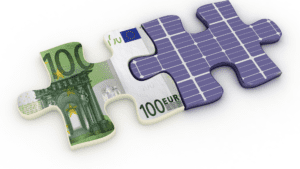- Business Transformation
- Sales & Revenue Optimization
- Finance & Operations
- Information Technology
- Private Equity
- Healthcare & Life Sciences
- High Tech
- Manufacturing
- Explore All Industries →
- Advisory + Diagnostics
- Change Management
- Implementation Services
- Cloud Application Managed Services
- Integrations
- Data Analytics
- Accelerators
- Cloud Applications
- Success Stories
- Insights + Events
- About Us
The energy industry is transitioning to prioritize and invest more in renewables, with a total of 290GW of new renewable energy generation capacity added in 2021 alone – which trumps previous years by leaps and bounds. Goals are even higher for this year, leading many companies to leverage utilities and renewable energy consulting to meet demand and need.
In the US, a substantial amount of the estimated 46.1 GW of new electric generation capacity for 2022 will be in renewables – nearly half in solar alone at 21.5 GW, up 6 GW from 2021. Wind will account for another 7.6 GW, battery storage providing 5.1 GW, with the remaining still expected to come from natural gas and nuclear.
This switch to renewables requires an ability to dynamically plan and account for how this transition aligns with strategic goals and initiatives, as well as accounts for cost savings and tax credits. Many energy companies lack processes and systems that enable them to plan properly, especially for the landscape of renewable energy.
You need to be able to plan differently – rapidly and accurately.
Many current FP&A processes haven’t been modernized to adapt to this new world that so heavily involves renewable energies. While there have been accounting and financial considerations made since the early 2000s, operational planning around renewable energy has not been a primary consideration until recently.
Due to investor pressure, climate change, and the United States’ goal to reach 100 percent carbon pollution-free electricity by 2035, for example, there’s expectation – and demand – for companies to reduce their carbon emissions and supply clean, renewable energies.
Although global conflict has recently led to an uptick in CO2-emitting coal generation, expectations are higher than ever that companies take the right steps toward increasing clean, renewable energy use. How are you transitioning your business to meet both regulations and demand?
The Many Factors of the Energy Transition
Energy transition is the global energy sector’s shift from fossil fuels – oil, natural gas, and coal – to renewable energy sources, including wind, hydro, and solar.
Many companies are committing to Environmental, Social, and Corporate Governance (ESG) since it was coined in 2005. It’s an initiative that’s unique to every company that implements it and involves evaluating to what extent a corporation works on social goals – such as environmental goals and DE&I – usually in a fashion that maximizes profits for shareholders.
Decarbonizing, or reaching net-zero, can certainly fall within these ESG initiatives, which also adds another layer to forecasting energy transitions. On top of ensuring governmental compliance, there are also ESG goals handed down by leaders – and this is really just the beginning.
There are numerous factors to consider, including:
- Government incentives and regulations
- ESG
- Investor standards
- Customer sentiment
- View of the workforce and broader society
It’s also important to note that investors are prioritizing companies that focus on decarbonization, net-zero initiatives, and other ESG factors, including Blackstone, a company that sees an opportunity to invest an estimated $100 billion in energy transition and climate change solutions.

Consumer demand is increasing, as are government and global initiatives. For all of the benefits, though, there are still significant challenges for companies that lack the resources or openness to change their existing and outdated planning process platforms:
- Customized FP&A for renewable resource planning
- Scenario modeling
- Value creation
- Carbon emissions monitoring
- Business model reinvention
… to briefly name a few. This is where utilities and renewable energy consulting can come in handy, strategizing and implementing a customized connected multi-cloud solution to ease the burden, including a comprehensive xP&A technology and, surprisingly, a CRM technology with advanced capabilities.
These tools allow ESG and strategic goals to be planned against the operational side of the business. Being able to accurately track against these initiatives is critical to drive value and stakeholder investment.
Spaulding Ridge’s Connected Forecasting & Planning Energy Transition Solution Leveraging Anaplan
Forecasting and planning for renewable energy the same way that’s been done for nonrenewable energy isn’t the way to successfully transition. Many utilities are still using inefficient and slow systems that:
- Don’t allow for easy changes to planning efforts
- Don’t provide accurate views of where the business stands as utilities operate differently by function
- Don’t account for necessary considerations, cost efficiencies, and capital gains accurately for renewables
Using Anaplan’s flexible Connected Planning platform, utilities can plan for the different associated revenues, costs, and credits available, including the Solar Investment Tax Credit (ITC) and the Renewable Electricity Production Tax Credit (PTC).
All considerations can be accounted for on a global scale to take advantage of cost efficiencies and government credits, like ITCs and PTCs in the United States, that come with an investment in renewable energy. The impact of these credits can easily be accounted for over time, and as the credits lapse, the cost savings developed because of the investment in renewables can be recognized.
The platform also helps answer all of the what-ifs with scenario planning, allowing you to thoroughly understand the benefits and drawbacks of reallocating capital away from coal to renewables, the downstream customer impacts, and even answer critical questions like “can you generate enough energy to meet demand?”
The key is high visibility, something Anaplan undoubtedly provides. Financial planners can see where they stand operationally against executive and strategic goals put in place to satisfy investors.
Net Zero Cloud
To measure effectiveness of company measures, you need a way to collect, categorize, and analyze energy usage and greenhouse gas emissions data – this is where Salesforce’s Net Zero Cloud tool comes in handy.
Results are the most satisfying aspect of any project or initiative and Net Zero Cloud makes it easy to measure your carbon footprint. Using global emission factors to calculate your greenhouse gas emissions, the platform shows your journey towards achieving all goals.
Anaplan x Salesforce x Spaulding Ridge = Your Utilities and Renewable Energy Consulting Solution
Spaulding Ridge is a global advisory and implementation firm with expertise in xP&A, CRMs, and the Utilities industry. We leverage Anaplan’s entirely customizable cloud-based platform to account for real-time data and renewable energy planning efforts, then can measure the results using Salesforce’s Net Zero Cloud technology.
While everyone agrees that the transition to renewable energy won’t be the easiest undertaking, it will be well worth it. Set the foundation for your energy transition by leveraging best-in-cloud technology implemented by an expert implementor.
Contact Jenn Ruder to talk about dynamically planning and accounting for the transition to renewable energy.







